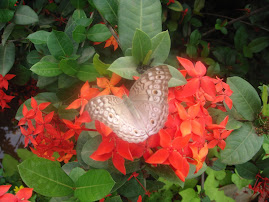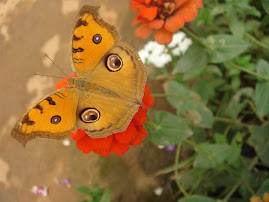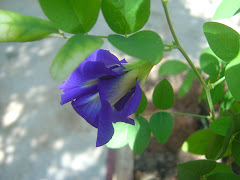
One of the most fragrant flowers to bloom in this season is
the Coral Jasmine. It is also known as the Night Jasmine and
the plant is known as The Tree of Sorrow or The Sad Tree. It's
well into the season because the flowering period is from
September to December. In Hindi it's called "Harsinghar". In
Assam it is known as "Sewali".
The flowers bloom at night and by dawn they fall to the ground.
The fragrance that wafts into the surrounding area is heavenly!
In the morning the ground below the tree forms a carpet of white
and orange. As you can see from the photo, the blooms are small
and white with a bright orange tube. These are usually picked up
and used for worship or kept in bowls and platters for the frag-
rance.

The botanical name of this tree is Nyctanthes arbor-tristis
which means a night flowering sad tree. Bereft of its blooms
in the morning the tree appears sad!
This is a small tree which can grow upto 4 mtrs. It needs a well
-drained soil and full to partial sun. It needs good sunlight
for profuse flowering. It also bears green fruit capsules
with one or two seeds.The leaves, grey bark and flowers all
have medicinal properties. In Ayurvedic medicine, the leaves
are used in the treatment of sciatica, arthritis, fevers,
various painful conditions, liver disorders and as a laxative.
The flowers are believed to keep diabetes under control. The tree's
medicinal properties range from treatment of stomach diseases,
piles, common cough and cold. Apart from these, the leaves are
used for polishing wood (it's abrasive) and cleaning utensils.

For a flower as beautiful and aromatic as this will surely be asso-
ciated with our mythology. It is said that Lord Krisna brought it
from the heavens!
Apart from India, this tree also grows in Indonesia, Thailand,
Nepal and Pakistan. Found in many gardens all over India, it is
also grown in the courtyards of temples. Blooms offered to the
gods are generally not picked up from the ground but with the
coral jasmine, there's an exception. Buddhists also venerate
this "night flowering sad tree".

It's always good to add something bitter to your diet! I made a
simple fish curry with these pretty blooms...












































.jpg)
































20 comments:
This is so interesting. I can just imagine how fragrant the blooms are. I always look forward to seeing and learning about something new and unique from you. Hope you have a pleasant weekend.
Fascinating information, Kanak! I'm wondering how a tree so full of life and healing properties could be thought of as sad. Maybe it expends too much of its prana (life force) while blooming. Would you mind providing the recipe for the curry dish? I am always looking for an interesting way to prepare fish. I love jasmine tea, which can be a little bitter but so refreshingly different.
Well that is definitely an interesting tree. I have to agree with walk2write. It's odd that it is called sad with all those great features. I guess it does look a little sad though with all the blooms gone. Thanks for the info Kanak. Hope you have a great weekend!
It is absolutely beautiful, sad tree or not. I love the night fragrant plants. And I also actually really love curry. It looks so delish. Which reminds me...it is dinnertime. I am glad you provided the latin name. Thanks so much and love those blooms in the food.
There was a night-blooming jasmine (probably a different variety) outside my window in college (near San Francisco, CA) and that smell always reminds me of my youth! Ah, how fast it passes. Maybe it's a "sad tree" for me now these days, or at least a wistful one! Thanks for this lovely post.
I love those pretty jasmine flowers. I can imagine their lovely scent. My granddaughter's name is Jasmine.
I didn't know the tree had so many medicinal properties.
Very interesting.
I didnt know about this flower's use to control diabetes - that's really interesting! I've always loved its bright orange tubes, though. Very individualistic.
Kanak-is this also called Husnahuna? How on earth did you make the fish curry-do send me the recipe.Aould love to try it.Indrani
Mildred, thank you so much for your kind words. Wish you the same!
Walk2Write, you're right about prana, I think. After bearing, the tree must think it unfair that the blooms would turn deserters. And so soon!
I've never tried jasmine tea. I think I'm too much of the usual tea tea- person!!
For this curry I've used onion paste, slit green chillies, turmeric, salt, oil and water.
Rub some turmeric and salt on the fish pieces. Heat oil. When the oil comes to smoking point add the fish pieces. Fry till they turn a light brown--they should be not be fully cooked. Drain and keep aside.
In the same oil fry the onion paste, add the slit green chillies, turmeric and salt. When any powdered spice is added a little water should also go into the wok/pan so that the spice does not burn. Then add the washed blooms and fry for a few minutes. Add some hot water-- about two cups. When it comes to the boil add the fried fish and let it cook for a few more minutes till the fish is done.
Here, very few spices are used because of the medicinal properties of the flowers. And since flowers are so tender they shouldn't be cooked for long. I hope you'll like trying it out!
Thank you for asking.
Exactly what I feel too, Susie. I suppose poetic minds had expressed this feeling a long time ago....
Tina, glad you like curries. And fragrant plants of the night!
Karen, glad it reminded you of carefree days...thanks for stopping by.
Wendy, thanks. And Jasmine is a lovely name!
Individualistic, yes! Sunita, while I was scouring the net for more facts on this plant I did not come across the diabetes bit. But my brother-in-law who's diabetic, and many people from these parts, have faith in this belief.
These flowers and tree are from my sister's garden. My brother-in-law usually starts his day with a brisk walk then comes back and picks up the blooms--to be cooked later by his wife!
Hi Indrani, about whether this is called husnahuna, I really don't know. But I find these blooms less bitter than bitter-gourd. I've written the recipe above. Hope you'll like it!
I can just imagine how fragrant that bowl of blossoms must be. What an interesting tree.
A very interesting post. Thanks for sharing!
Katarina
Racquel, thanks. The fragrance is indeed special.
Katarina, thank you for stopping by.
Heavenly! I can smell them from here. I love when blooms litter the ground, it is my type of 'snow'.
Carla, I agree. I love the way you've put it.
Thanks for the recipe, Kanak. It sounds and looks like it would be delicious. What kind of fish do you use? Here, catfish, bluegill, bass, and crappie are the fish locally available. I'm hoping Hubby can catch a few for me soon. He says be patient and wait for the weather to get a little warmer, which means I'll probably be waiting until spring! As for the flowers, I guess I will have to substitute nasturtium blossoms (again, have to wait a few months) for the coral jasmine flowers. I will be saving your recipe and looking forward to preparing it.
W2W, wow! Fresh fish and that too caught by Hubby!! I had to google to find out the English equivalent of the fish we normally have, we use the Assamese names only. The fish I used for the dish was Rohu (Labeo rohita).
The markets are usually stocked with different kinds of catfish, carp, mahseer, Indian shad, humped feather back, barb and minnow.
I've never tried nasturtium blooms before but I'll be trying them out once my plants blossom.
Have a lovely (coming) week!
What a lovely post.Being from Assam ,this post was especially close to my heart.
I stumbled across your blog quite by accident while googling for
recipes using the night jasmine.In Assam ,these flowers are incorporated into quite a few dihes.To name a few rice pancakes,khar a type of alkaline dish,fritters and fish curries
Lovely recipe of the fish curry.
Regards
Sharmin
Got to know about many details about the coral jasmine flower. Thanks a bunch for sharing these!
I have written an article about this flower in my Tamil blog and shared the link of your blog.Thanks again!
Where can I buy this plant in India?
Thanks for this amazing informative post. Can you please guide me how can I get this tree. I think it's also called Parijaat tree. And this was all alone tree in the whole world.. it was a Shrarapit tree according to Mahabharata . This is said that this tree is I placed Bihar, India and only one male tree without female content ...
Post a Comment